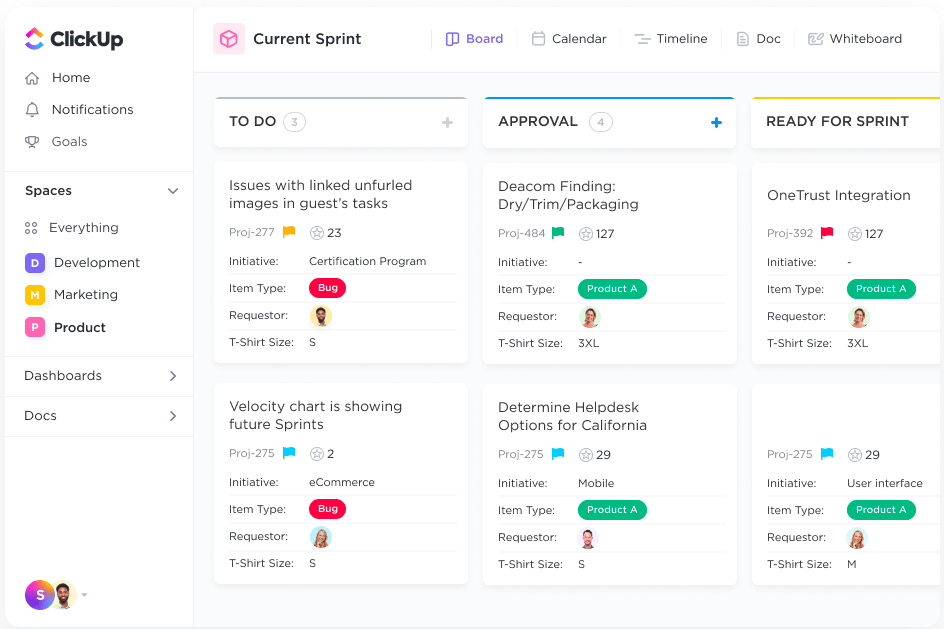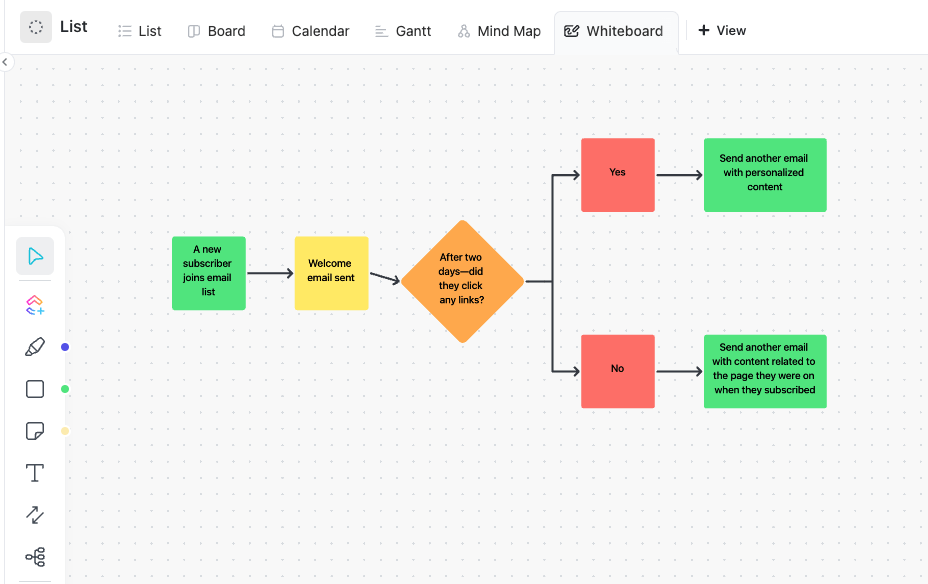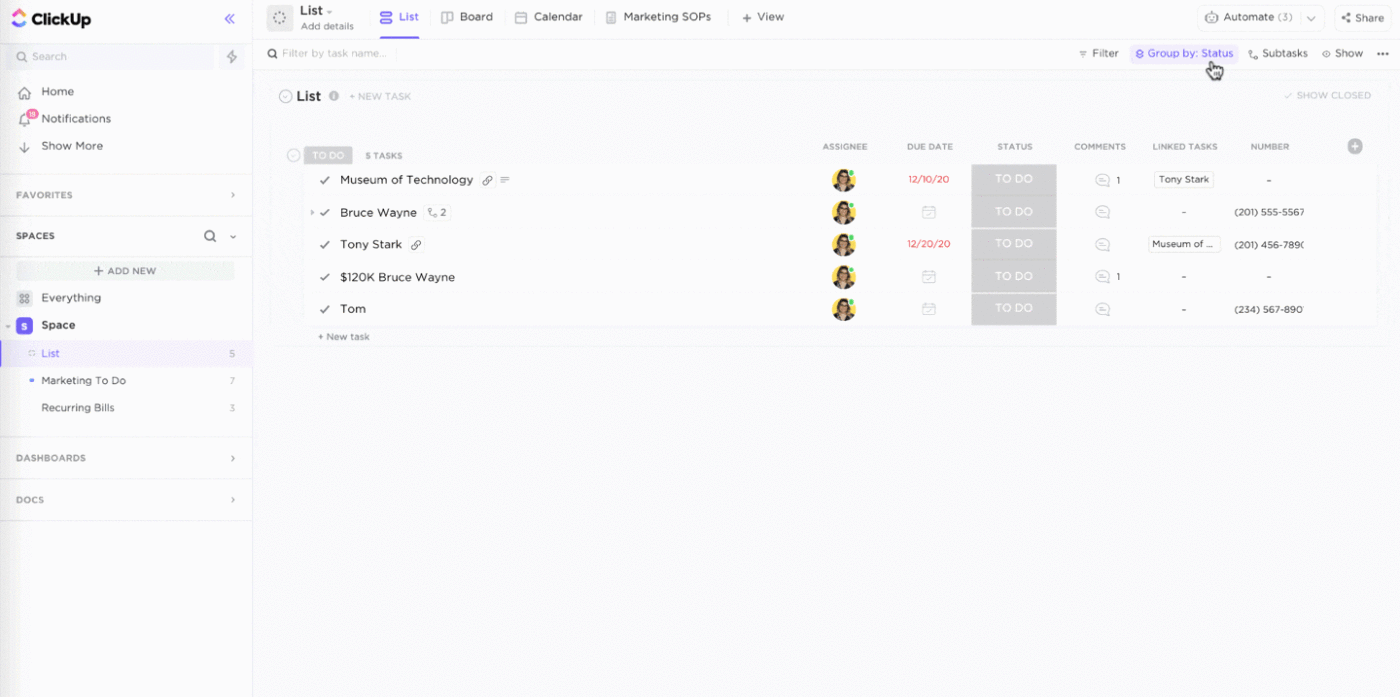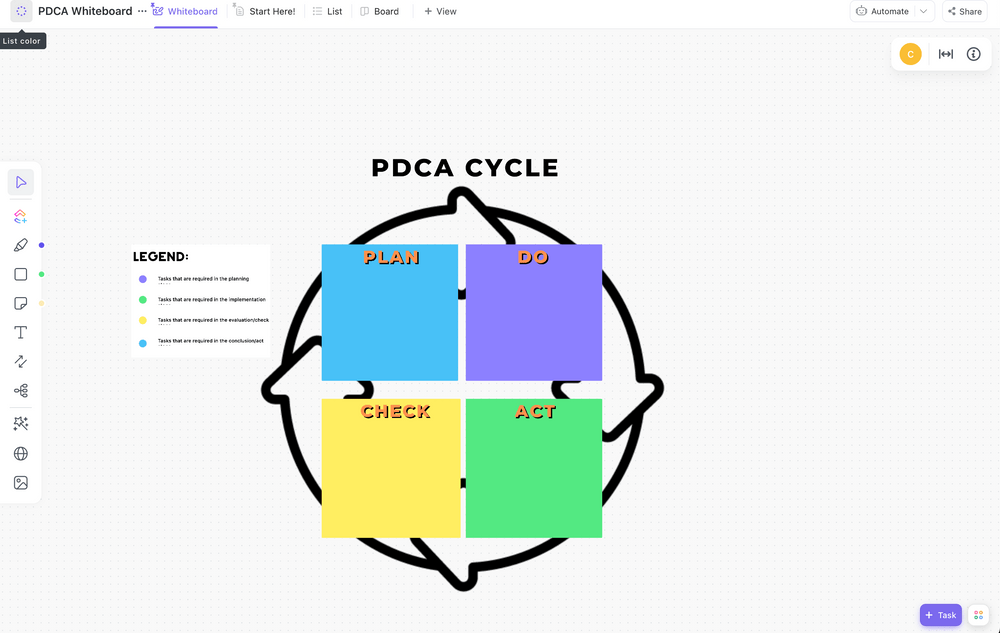إليك الأمر: في انقر فوق نحن أشخاص معالجون. ويجب أن تكون كذلك! هل تعلم لماذا؟
تساعد العمليات التجارية المحددة جيدًا المؤسسات في تحديد كيفية عملها. كما أنها تساعد القادة على فهم كيفية إدارة الشركات بكفاءة أكبر .
لكن الجمال الأكبر في العمليات التجارية يكمن في قدرتها على الاستفادة من الشركات. ففي نهاية المطاف، ما هي الأعمال الناجحة التي لا تعمل بكفاءة؟ هذا صحيح! لا يوجد.
إذن كل ما عليك فعله هو تعلم حبال إدارة العمليات - إدارة عمليات الأعمال (BPM)، على وجه التحديد. ولهذا السبب وضعنا هذه المقالة من أجلك.
ستتعرف على ماهية إدارة عمليات الأعمال، وسبب أهميتها، وما الذي تستلزمه. وستعجبك النماذج والأمثلة التي قمنا بتجميعها لك واقتراحاتنا لتحسين عمليات أعمالك باستخدام الأدوات المناسبة.
دعنا نبدأ على الفور حتى تتمكن من تسريع عمليات أعمالك التجارية قدر الإمكان!

ما هي إدارة العمليات؟
تحلل إدارة العمليات العمليات العمليات الحالية داخل المؤسسة، وتحدد العمليات الجديدة وتصفها، وتتحكم في تنفيذ كل من العمليات الحالية والجديدة لضمان إتمامها كما هو موصوف.
والهدف النهائي من القيام بكل ما سبق هو تحسين - أو تحسين - عمليات الأعمال. والآن، ما هي عمليات الأعمال بالضبط؟
العملية التجارية هي سلسلة من المهام (أو الخطوات) التي يقوم بها دور واحد أو أكثر لإنتاج مخرجات وبالتالي تحقيق هدف ما. وإذا كان الهدف، على سبيل المثال، هو الوصول إلى هدف رئيسي ، فإن العملية التجارية هي تعريف لكيفية الانتقال من مرحلة إلى أخرى.
أمثلة على إدارة العمليات
يمكنك أن تستنتج بسهولة أن إدارة عمليات الأعمال هي تعبير عن العمل الجماعي لأنه قد يشمل عدة أشخاص. وعملهم معًا كفريق أو منظمة هو ما يجعل عملية العمل تنبض بالحياة.
مثال على إدارة العمليات رقم 1: تنفيذ طلب عبر الإنترنت للدونات
- يقوم أحد العملاء بطلب شراء 100 قطعة دونات عبر الإنترنت
- يقبل مدير المتجر الطلب ويمكن للعميل التحقق من حالة الطلب
- هل هناك دونات كافية جاهزة للتعبئة
- نعم: يقوم الموظفون بتعبئة الدونات
- لا: يقوم أحد الموظفين بإعداد ما يكفي من الكعك المحلى لتلبية الطلب، بينما يقوم موظف آخر بتجهيزها
- يقوم موظف بإصدار إيصال وتعبئة الكعك وتحديث حالة الطلب إلى جاهز
- موظف يقوم بتسليم الكعك المعبأ إلى ساعي البريد
- يقوم الساعي بتحديث حالة الطلب إلى تم التسليم
مثال على إدارة العمليات #### مثال على إدارة العملية رقم 2: تأهيل موظف جديد
- يتلقى قسم الموارد البشرية خطاب العرض الموقع من المرشح
- ينشئ فريق الموارد البشرية سجلاً للموظف ويرسله إلى قسم تكنولوجيا المعلومات لإعداد الحساب
- تقوم تكنولوجيا المعلومات بإعداد البريد الإلكتروني والكمبيوتر وكلمة المرور للموظف الجديد
- يحدد فريق الموارد البشرية موعداً لاجتماع توجيهي ويضع جدولاً زمنياً لتدريب الموظف الجديد
- يحضر الموظف الجديد اجتماع التوجيه ويبدأ التدريب
- بعد الانتهاء من التدريب، يبدأ الموظف الجديد العمل على المهام الموكلة إليه بتوجيه من مديره
- يقوم المدير بتقييم التقدم الذي أحرزه الموظف خلال الأسابيع الأولى ويقدم ملاحظاته إلى الموارد البشرية
مثال على إدارة العمليات رقم 3: تطوير المنتج
- يحدد فريق العمل حاجة العميل أو الفجوة في السوق
- يقوم الفريق بإجراء بحث لفهم الحاجة/الفجوة والحلول المحتملة
- بناءً على البحث، يضع الفريق خطة لتطوير المنتج بما في ذلك الجداول الزمنية والأدوار والموارد اللازمة
- يقوم الفريق بتصميم المنتج وإنشاء نموذج أولي للاختبار
- يتم اختبار النموذج الأولي مع العملاء المحتملين لجمع الملاحظات وإجراء التحسينات
- يتم إنشاء المنتج النهائي وطرحه في السوق
- يقوم الفريق بجمع وتحليل البيانات حول المبيعات وملاحظات العملاء وأي تغييرات ضرورية يجب إجراؤها لتحديثات المنتج المستقبلية.
إذا كنت تتساءل عما ينقصك أو ما الذي يمكن أن يحدث بشكل مختلف في هذه العملية، فنحن فخورون بك! لأنك تقوم بضبط روح إدارة العمليات التجارية.
مكافأة:_
_/مرجع/ مدونة؟ p=49653_ أدوات تخطيط العمليات *%/href/_
لماذا تعتبر إدارة عمليات الأعمال مهمة؟
إذا كنت تأخذ كفاءة العمل على محمل الجد - كما نعتقد أنك تفعل - فيجب أن تكون في إدارة عمليات الأعمال. هذه هي الطريقة التي ستحقق بها أهداف عملك بسلاسة وسرعة وبموارد أقل.
بدون الإدارة السليمة لعمليات الأعمال، لا يعرف الجميع من المسؤول عن أي المهام في المشروع. ويصبح هذا الأمر أكثر صعوبة عند إضافة فرق إضافية إلى المعادلة.

تحافظ سباقات السرعة في ClickUp على توافق الفرق حول خرائط طريق المنتج للحصول على رؤية كاملة حول من يقوم بماذا
تحتاج الفرق بالتأكيد إلى رؤية واضحة للعملية في جميع المراحل عندما تشارك مجموعات متعددة. وتربط إدارة العمليات بين جميع الأجزاء المتحركة في المؤسسة لتقديم القيمة إلى أصحاب المصلحة في المشروع وفي النهاية العمل.
5 مراحل إدارة العمليات
تعتبر عمليات إدارة العمليات التي تهدر الوقت أو الموارد غير الضرورية غير فعالة. ويجب عليك إما أن تجعلها فعالة أو تلغيها.
ولكن هنا تكمن المشكلة: تحديد و تحسين العمليات غير الفعالة يمثل تحديًا. لأنك تعلم أنه عندما تترسخ عملية ما في المؤسسة، فإن تغييرها يثير مقاومة، على أقل تقدير. لسوء الحظ، عليك تحسين العمليات في شركتك باستمرار على أي حال.
للقيام بذلك، اتبع دورة حياة إدارة عمليات الأعمال:
المرحلة 1: التخطيط
في هذه المرحلة، يجب أن تبدأ بتحليل استراتيجية عمل الشركة. هذا هو الاتجاه الذي تريد مؤسستك أن تسلكه حتى تحقق أهدافها في المستقبل. وستوجه هذه المعرفة دورة حياة إدارة عمليات الأعمال بأكملها - إنها حجر الزاوية فيها.
لوضع خطة إدارة العمليات في مكانها الصحيح، تحتاج أولاً إلى:
- فهم أهداف العمل الحالية للشركة,الأهدافوالاستراتيجية
- تحديد عمليات الأعمال الموجودة داخل المؤسسة والتمييز بين ما تم تحليله وتعريفه ووصفه بالفعل وما لم يتم تحليله ووصفه
- اكتشاف قواعد العمل التي تحكم جميع تلك العمليات
- كشف ما إذا كانت كل عملية تعاني من نقاط ضعف، مثل الاختناقات أو التكرار أو النفقات العالية
- حدد ما إذا كانت كل عملية تتوافق مع النتائج التي توصلت إليها من رقم 1
بعد ذلك، بناءً على الرؤى التي تعطيك هذه الخطوات، لديك بعض الخيارات لما يجب القيام به بعد ذلك. يمكنك إما
- تصميم ومستند عملية الأعمال العمليات الحالية المحددة
- قم بتحديث أو استكمال العمليات التي لا تتماشى مع أهدافك أو أهدافك أو استراتيجيتك، أو التي تفتقد قواعد العمل المهمة، أو التي تحتوي على نقاط ضعف وعدم كفاءة
شطف وتكرار نصيحة احترافية: احرص على تكرار مرحلة تخطيط العمليات مرة واحدة على الأقل كل عام لأنه قد تظهر عمليات جديدة. وبهذه الطريقة تكون دائمًا على اطلاع دائم على عمليات عملك.
المرحلة 2: النموذج
خلال هذه المرحلة، يجب عليك تصميم وتمثيل العمليات التجارية، مع الأخذ في الاعتبار أنها تنسق إجراءات الأدوار والأنظمة المختلفة (ليس بالضرورة أن تكون تكنولوجية دائمًا) والمعلومات والأشياء (اعتمادًا على عملك).
ونعني بـ التصميم وضع تصور لكل عملية ورسم سير عمل (أو مجموعة من عمليات سير العمل) لها حرفيًا. بصرياً، هذه هي الرسوم البيانية أو المخططات الانسيابية، والتي يمكن تضمينها في أدوات إدارة المشاريع مثل ClickUp!

مثال على سير عمل حملة بريد إلكتروني تم إنشاؤها باستخدام ClickUp Whiteboards
إذا قرأت أو سمعت عن إدارة سير العمل ، وذلك لأن العمليات التجارية يتم تمثيلها بسير العمل (في بعض الأحيان، العديد من عمليات سير العمل). لكن إدارة عمليات الأعمال هي أكثر من مجرد إنشاء وتحسين سير العمل، وهو محور إدارة سير العمل.
احذر أيضًا من أنه في كثير من الأحيان، يقوم محترفو إدارة العمليات بإنشاء مخططات سير العمل باستخدام نموذج وترميز عملية الأعمال (BPMN) .
تحقق من أفضل مجموعة مختارة من أمثلة على سير العمل !
المرحلة 3: التنفيذ
لتنفيذ العمليات التجارية التي قمت بتصميمها مسبقًا، يجب عليك استخدام أداة إدارة الأعمال . وإليك الخطوتين الذهبيتين اللتين ننصحك باتباعهما عند تنفيذ العمليات باستخدام الأداة التي تختارها:
- اختبار كل عملية مصممة حديثًا مع عدد قليل من المشاركين من فريق أو قسم واحد
- السماح تدريجيًا لبقية مؤسستك باعتماد العملية
سيقلل هذا النهج الحذر في تنفيذ العملية من تأثير عيوب التصميم المحتملة.
المرحلة 4: المراقبة
هل عملياتك التجارية قيد التشغيل؟ نعم. إذن يجب عليك تحليلها لترى كيف تعمل بالضبط.
تساعدك مراقبة العمليات على تحديد الاختناقات والمهام المتكررة والمشاكل الأخرى التي يجب عليك إصلاحها. على مستوى أعمق، تعني مراقبة العملية الحالية فحص كل جزء من أجزائها بدقة. أتمتة العمليات التجارية يقلل من العمل اليدوي لهذه المهام المتكررة.

قم بأتمتة مهامك المتكررة ببضع نقرات فقط من خلال واحدة من مئات أتمتة سير العمل القوالب
الهدف من ذلك هو تحديد الأجزاء التي تعمل بشكل جيد والأجزاء التي تحتاج إلى تحسين (بالإضافة إلى نوع التحسين الذي تحتاجه). تحليل عميلك أو تأهيل العميل طريقة فعالة لتحديد كيفية تأثير تنفيذها على مستويات مشاركة العملاء لديك.
وقد تحصل على إشارات تدل على وجود خطأ ما في العملية من خلال التنقيب في بيانات سجل الأحداث من أنظمة المعلومات المشاركة في عملية التأهيل. سيكون ذلك نهجًا قائمًا على البيانات لفهم أداء العملية.
ويمكن أن يمكّنك من اكتشاف عمليات جديدة تلقائيًا من بيانات تحليلات العمليات. ولكن كيف يمكنك تحليل العمليات فعليًا؟ باستخدام أداة مراقبة عمليات الأعمال.
تمامًا مثل تقرير فحص الدم، تقوم هذه الأداة بتقييم صحة عملياتك. على سبيل المثال، قد تقوم بتقييم رضا العملاء, وقت الدورة والإيرادات والإنتاجية والعديد من المقاييس الأخرى.
ومع ذلك، مثل الفحص الطبي، يجب عليك تكراره كل بضعة أسابيع أو أشهر. وإلا، فقد لا تدرك أن عملياتك تعاني من أوجه قصور إلا بعد فوات الأوان لتجنب فشل العمليات (مع كل التكاليف والجوانب السلبية المرتبطة بها).
تأكد من أتمتة العمليات التجارية تُستخدم الأدوات لتقليل الوقت الذي تستغرقه في إنجاز أعمالك اليومية. تحتاج خطة إدارة العمليات بأكملها إلى الاهتمام بمساحات محددة - أكثر من غيرها.
المرحلة 5: التحسين
تتمحور مرحلة التحسين - أو مرحلة التحكم - حول ضبط عملية الأعمال اللازمة للتحسين. هذه هي الطريقة التي تحافظ بها على كفاءتها وتحقق أهداف أعمال شركتك وخطة إدارة العمليات الشاملة.
بعض أمثلة على إدارة العمليات التحسين قد تشمل:
- التخلص من المهام أو العمليات الزائدة عن الحاجة
- أتمتة مهام سير العمل
- تحسين التواصل بين المتدخلين في العملية مع المناسبأدوات العمل ولا تنسَ مراقبة العمليات التي قمت بتحسينها! ففي النهاية، هذه دورة.
## قوالب إدارة العمليات لتبدأ الآن
لنعد إلى فكرة أنه يمكنك تحسين العمليات التجارية من خلال تبسيط سير العمل. وأنك تبسط سير العمل من خلال الأتمتة.
حسنًا، قوالب إدارة العمليات هي أحد أسس أتمتة سير العمل. والقوالب الثلاثة أدناه هي تلك التي نوصيك بإلقاء نظرة عليها عند البدء في إدارة سير العمل.
1. قالب السبورة البيضاء لعملية ClickUp PDCA

قسّم جميع مهامك بسهولة إلى أربع مراحل: التخطيط، والتنفيذ، والتحقق، والتصرف
إذا كنت تعمل في مجال إدارة الجودة، فأنت تعرف بالفعل دورة التخطيط والتنفيذ والتحقق والتصرف (PDCA) - أو التحسين المستمر الدورة. ولكن هذا ClickUp PDCA قالب السبورة البيضاء سيرفع خطة إدارة عملية PDCA الخاصة بك إلى مستوى آخر تمامًا.
استخدمه لتصنيف المهام في المراحل الأربع لدورة PDCA. قد يبدو من السخف القيام بذلك باستخدام قالب بدلاً من القلم والورقة ولكن ثق بنا.
يستخدم قالب السبورة البيضاء هذا برنامج إدارة عمليات الأعمال ويقوم بأكثر من مجرد تقسيم المهام إلى خطوات أصغر. تدعم اللوحة البيضاء PDCA تنفيذ عمليات PDCA لتحسين إدارة المشروع.
تنزيل قالب PDCA
2. قالب مستند عمليات الشركة ClickUp

استخدم قالب مستندات ClickUp Docs هذا لتوثيق إجراءات التشغيل الموحدة، وعمليات طلب الإجازات، والمزيد
مع قالب مستند عملية ClickUp أصبح توثيق العمليات التجارية أسهل بكثير. استخدم القالب لتوثيق إجراءات التشغيل القياسية (SOPs) مثل خطوات طلب إجازة لتحسين العملية.
لأن تحديد المهام في سير عملك شيء، ومعرفة ما يجب القيام به بالضبط لإكمال المهمة شيء آخر.
للمزيد جرب هذه قوالب مستند العملية !
تنزيل قالب عمليات الشركة
3. انقر فوق العمليات والإجراءات التجارية قالب عمليات وإجراءات العمل

قم بتمييز مهامك اللازمة لإنشاء وثيقة عملية حية
بمجرد أن تبدأ شركتك في تنفيذ العمليات التجارية باستخدام برنامج إدارة الأعمال والإجراءات، استخدم هذا قالب العمليات والإجراءات من ClickUp للحصول على نظرة عامة على عملياتك الداخلية من خلال:
- الحصول على تفاصيل تحسين العمليات من خلال تواريخ الاستحقاق والأولويات ومعدلات الإنجاز وعدد المهام المنجزة (مع تجميع العمليات، على سبيل المثال، حسب القسم)
- المهام التي تتطلب إنشاء مستندات والمرحلة التي وصلت إليها تلك المستندات
- كيف ستتدفق العمليات إلى بعضها البعض من خلال نظام إدارة المشروع
تنزيل نموذج العمليات والإجراءات
المكافأة:
_/مرجع/ *مدونة؟ p=65707_ برنامج_SOP *%/href/_
!
تحسين إدارة العمليات باستخدام برمجيات إدارة عمليات الأعمال
تساعدك مجموعة برمجيات إدارة عمليات الأعمال - التي تتألف من العديد من خيارات برمجيات إدارة عمليات الأعمال - على تنفيذ جميع مراحل إدارة عمليات الأعمال. لذا، قبل أن نبدأ، دعنا نخبرك عن بعض النقاط القوية في أدوات إدارة عمليات الأعمال وإدارة المشاريع (مثل ClickUp).

تصوّر المهام والمشروعات وسير العمل بالطريقة التي تناسبك بشكل أفضل مع أكثر من 15 طريقة عرض قابلة للتخصيص من ClickUp
- إنها تقوم بأتمتة سير العمل: اجعل جميع العمليات التجارية للشركة تنبض بالحياة وتخلص من العمل اليدوي والمتكرر من خلال عمليات أتمتة محددة مسبقًا ومخصصة.
- يدعمون التعاون: توضيح الإجراءات دون فقدان سياق العملية أو رسائل البريد الإلكتروني مثل إبرة في كومة قش. تسمح أدوات إدارة عمليات إدارة الأعمال لأعضاء الفريق بالتعليق على المهام وإرفاق الملفات بتلك المهام. حتى أنها تمكنك من تحويل التعليقات إلى مهام!
- تقدم تقارير: توفر بيانات عملية شاملة يمكنك الاعتماد عليها للتحقق مما إذا كنت قد صممت عملياتك بفعالية. تقوم هذه التقارير بتحليل أداء الفريق، مما يتيح لك التحقق من إنتاجيته خلال فترة معينة.
فوائد أتمتة العمليات التجارية
المراحل الخمس لإدارة عمليات الأعمال هي خطوات ضرورية نحو الأتمتة. وتساعدك أدوات إدارة عمليات الأعمال مثل ClickUp على أتمتة المهام وسير العمل، ولهذا السبب نريد تسليط الضوء هنا على فوائد أتمتة عمليات الأعمال:
- كفاءة الوقت والتكلفة: توفر أتمتة المهام المتكررة الوقت والمال، مما يسمح للموظفين بالتركيز على مهام أكثر أهمية.
- زيادة الاتساق والدقة: تقلل الأتمتة من الأخطاء البشرية، مما يؤدي إلى زيادة الاتساق والدقة في العمليات. وهذا يؤدي أيضاً إلى تحسين رضا العملاء.
- تبسيط العمليات: تساعد أتمتة العمليات التجارية على تبسيط العمليات وإلغاء الخطوات غير الضرورية وتبسيط الإجراءات.
- رؤى البيانات في الوقت الحقيقي: من خلال العمليات المؤتمتة، يمكنك جمع رؤى البيانات في الوقت الفعلي التي يمكن أن تساعدك على اتخاذ قرارات عمل أكثر استنارة.
وعادةً، يمكنك تخصيص التقارير باستخدام الأدوات التي تطلعك على المهام المنجزة، وعدد المهام التي تم إنجازها، والأعضاء الذين لديهم مهام غير منتهية، وتقديرات الوقت، والوقت الذي تم تتبعه، والعديد من المقاييس الأخرى. جرّب ClickUp وأرسل لنا رسالة لإبداء رأيك فيه. نحن متشوقون لمعرفة أين تريد أن تذهب في إدارة عمليات الأعمال!

